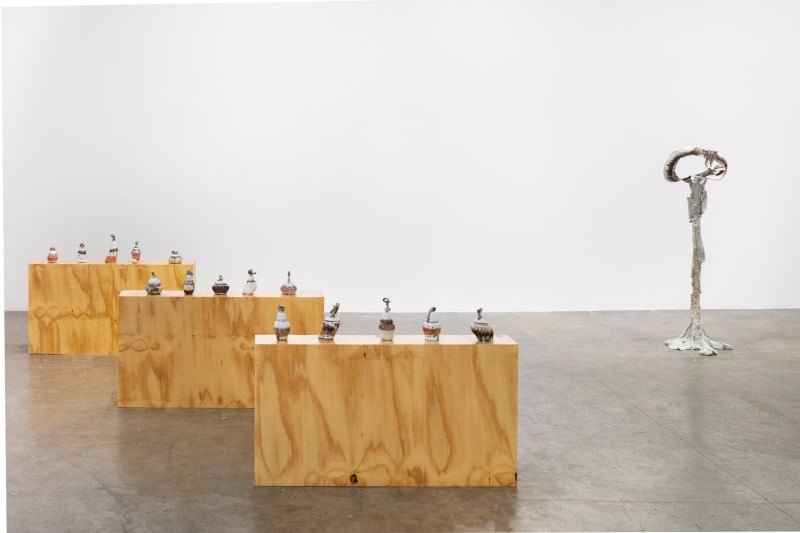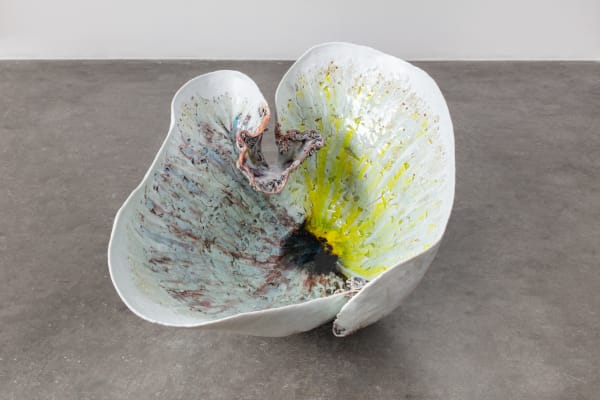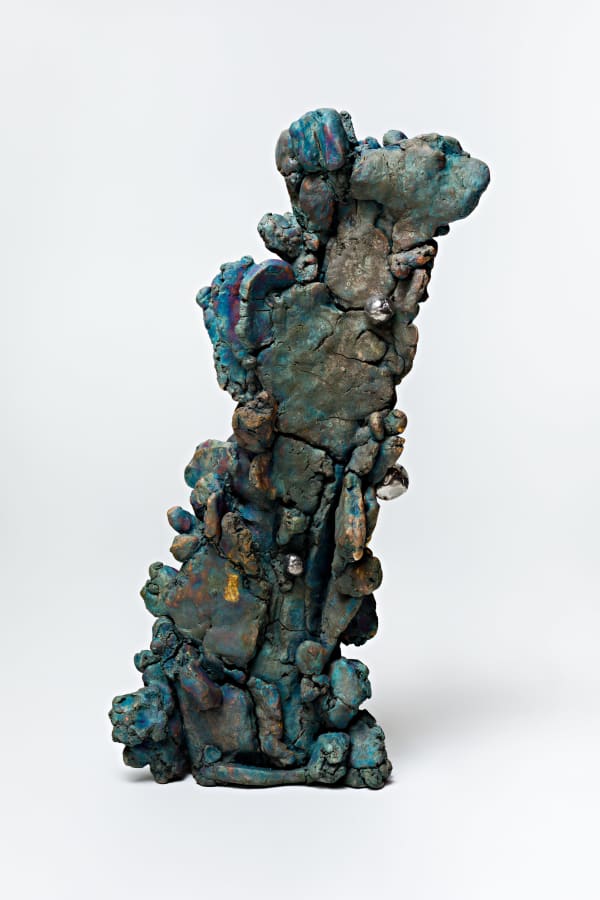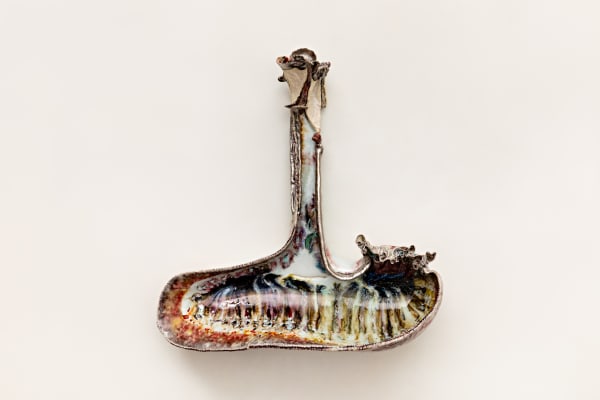Butterfly Joint Kentaro Kawabata
Past exhibition
Overview
Mendes Wood DM is delighted to present – at its gallery space in São Paulo – Kentaro Kawabata’s first solo exhibition in Brazil. Titled Butterfly Joint, the show brings together a poignant body of works produced by the Japanese artist, spanning four series of porcelain sculptures that are a testament to the re-composition of matter and nature’s renewing cycles. Butterfly Joint is also a symbolic way of looking at the artist’s work, in which the artificial and the organic merge and become whole.
Kawabata’s interests center on forms that are biomorphic but that do not discard a certain sense of oddness. The artist combines the knowledge in porcelain and experimentations with alchemical processes, tuning into the way pieces come together through the use of techniques that include burning glass inserted into porcelain and dipping silver into sulfurous water. The result is always vital, evoking the meandering work of fingers on the pieces’ edges and creating surfaces full of texture and detail.
In Kawabata’s work, there is no dissociation between the surrounded and the surrounding. Beauty is merged with the essential, with the heart of what must be touched. This is the case in the series Batista, whose title celebrates the artist’s contact with a Brazilian reference: the doctor who led the first heart failure surgery. In the work, the presence of cracks or gaps in the forms evokes the notion of failure, which the artist never discards as unimportant. Kawabata’s intention is to use failure as a way of amplifying the work’s unity. The surface’s shiny appearance, obtained through the treatment of enamel combined with several other materials, is added to the pieces’ biomorphic forms, reinforcing their vital character.
In other works, artistic making is presented as an offering, which is the case in the series Spoon, where the nature of the works represents the formal and symbolic condition of the spoon. The pieces show carefully refined surfaces, which is something achieved through the application of metals, such as silver, and the final details in platinum. Kawabata’s work is always alchemical, in the sense of transformation and maturing. However, this transformation always includes renovation – nature’s life and death. In works such as in the series Abandonment, the artist’s aim is to do justice to the disposed, creating forms that resemble discarded objects, such as baby diapers. Here, the artist’s practice also operates in an alchemical sense, recognizing in the discarded an element of life, of renovation.
In his respect for and devotion to materials, the artist sees the possibility of an ongoing cycle of rebirth. In the series Soos, Kawabata uses leftover and damaged materials from other works, such as from the series Batista. The title is a Japanese derivation from the English word "source", altered by the artist to SOOS to conform to the Japanese pronunciation of the English word. Also symmetrical, ‘SO’, means grass in Japanese, whilst ‘OS’ is a reference to operational systems. By also evoking a call for help – SOS – Soos reflects on matters of time and materiality: the new pieces, made from leftovers, have silver in their composition, a material that changes with time. The artist then takes these pieces to an onsen – a site of volcanic hot springs in Japan – and submerges the silver in high temperature sulfurous water, creating a patina that is unique in its color and texture.
Soos implies a respect for time – the artist sees a life flame in the transformation and the different states of matter. The series seems to be situated between a geological past and an apocalyptic future, whilst keeping the ability to retain. The application of different alchemical processes on porcelain suggests the endlessness of nature, the continuity of cycles. In Kawabata’s practice, no beauty is unrelated to the organic: the works look at the accumulation of processes and the disposal of matter, turning their biomorphic – and mysterious – appearance into a reflection of their essence.
Kentaro Kawabata (b. 1976, Saitama) lives and works in Gifu, Japan.
After graduating from the Tajimi City Pottery Design and Technical Center in 2000, Kawabata began winning awards for his work, including the Kamoda Shoji Award at the Mashiko Pottery Exhibition (2004) and the Paramita Museum Ceramic Award (2007). His work has been the subject of numerous solo and group exhibitions at highly-reputed ceramic institutions, including the National Museum of Modern Art’s Crafts Gallery, Tokyo (2019); the Ibaraki Ceramic Art Museum, Kasama (2014); and the Museum of Modern Ceramic Art, Gifu (2004, 2010).
Recent solo exhibitions include Yours Truly, High Art, Paris (2022); 凸凹 Bumpy, Nonaka-Hill, Los Angeles (2021); ishoken gallery vol.10: Kentaro Kawabata, ishoken gallery, Gifu (2020); Inside out, Silver Shell, Tokyo (2018); Hello from the Hollows2, Sokyo Gallery, Kyoto (2017); Kentaro Kawabata, Art Biotop, Tochigi (2016). Group exhibitions include Le Biscuit à Soupe, High Art, Arles (2022); Push + Pull, Mai 36, Zurich (2022); Gyeonggi International Ceramic Biennale, Icheon (2017); PUNK, Rakusuitei Museum of Art, Toyama, Japan (2016); CONTEMPORARY JAPANESE CRAFTS The Kikuchi Kanjitsu Prize II, Musee-Tomo, Tokyo (2016).
Kawabata’s interests center on forms that are biomorphic but that do not discard a certain sense of oddness. The artist combines the knowledge in porcelain and experimentations with alchemical processes, tuning into the way pieces come together through the use of techniques that include burning glass inserted into porcelain and dipping silver into sulfurous water. The result is always vital, evoking the meandering work of fingers on the pieces’ edges and creating surfaces full of texture and detail.
In Kawabata’s work, there is no dissociation between the surrounded and the surrounding. Beauty is merged with the essential, with the heart of what must be touched. This is the case in the series Batista, whose title celebrates the artist’s contact with a Brazilian reference: the doctor who led the first heart failure surgery. In the work, the presence of cracks or gaps in the forms evokes the notion of failure, which the artist never discards as unimportant. Kawabata’s intention is to use failure as a way of amplifying the work’s unity. The surface’s shiny appearance, obtained through the treatment of enamel combined with several other materials, is added to the pieces’ biomorphic forms, reinforcing their vital character.
In other works, artistic making is presented as an offering, which is the case in the series Spoon, where the nature of the works represents the formal and symbolic condition of the spoon. The pieces show carefully refined surfaces, which is something achieved through the application of metals, such as silver, and the final details in platinum. Kawabata’s work is always alchemical, in the sense of transformation and maturing. However, this transformation always includes renovation – nature’s life and death. In works such as in the series Abandonment, the artist’s aim is to do justice to the disposed, creating forms that resemble discarded objects, such as baby diapers. Here, the artist’s practice also operates in an alchemical sense, recognizing in the discarded an element of life, of renovation.
In his respect for and devotion to materials, the artist sees the possibility of an ongoing cycle of rebirth. In the series Soos, Kawabata uses leftover and damaged materials from other works, such as from the series Batista. The title is a Japanese derivation from the English word "source", altered by the artist to SOOS to conform to the Japanese pronunciation of the English word. Also symmetrical, ‘SO’, means grass in Japanese, whilst ‘OS’ is a reference to operational systems. By also evoking a call for help – SOS – Soos reflects on matters of time and materiality: the new pieces, made from leftovers, have silver in their composition, a material that changes with time. The artist then takes these pieces to an onsen – a site of volcanic hot springs in Japan – and submerges the silver in high temperature sulfurous water, creating a patina that is unique in its color and texture.
Soos implies a respect for time – the artist sees a life flame in the transformation and the different states of matter. The series seems to be situated between a geological past and an apocalyptic future, whilst keeping the ability to retain. The application of different alchemical processes on porcelain suggests the endlessness of nature, the continuity of cycles. In Kawabata’s practice, no beauty is unrelated to the organic: the works look at the accumulation of processes and the disposal of matter, turning their biomorphic – and mysterious – appearance into a reflection of their essence.
Kentaro Kawabata (b. 1976, Saitama) lives and works in Gifu, Japan.
After graduating from the Tajimi City Pottery Design and Technical Center in 2000, Kawabata began winning awards for his work, including the Kamoda Shoji Award at the Mashiko Pottery Exhibition (2004) and the Paramita Museum Ceramic Award (2007). His work has been the subject of numerous solo and group exhibitions at highly-reputed ceramic institutions, including the National Museum of Modern Art’s Crafts Gallery, Tokyo (2019); the Ibaraki Ceramic Art Museum, Kasama (2014); and the Museum of Modern Ceramic Art, Gifu (2004, 2010).
Recent solo exhibitions include Yours Truly, High Art, Paris (2022); 凸凹 Bumpy, Nonaka-Hill, Los Angeles (2021); ishoken gallery vol.10: Kentaro Kawabata, ishoken gallery, Gifu (2020); Inside out, Silver Shell, Tokyo (2018); Hello from the Hollows2, Sokyo Gallery, Kyoto (2017); Kentaro Kawabata, Art Biotop, Tochigi (2016). Group exhibitions include Le Biscuit à Soupe, High Art, Arles (2022); Push + Pull, Mai 36, Zurich (2022); Gyeonggi International Ceramic Biennale, Icheon (2017); PUNK, Rakusuitei Museum of Art, Toyama, Japan (2016); CONTEMPORARY JAPANESE CRAFTS The Kikuchi Kanjitsu Prize II, Musee-Tomo, Tokyo (2016).
Works
-
 Kentaro Kawabata, Abandonment, 2022
Kentaro Kawabata, Abandonment, 2022 -
 Kentaro Kawabata, Abandonment, 2022
Kentaro Kawabata, Abandonment, 2022 -
 Kentaro Kawabata, Abandonment, 2022
Kentaro Kawabata, Abandonment, 2022 -
 Kentaro Kawabata, Abandonment, 2022
Kentaro Kawabata, Abandonment, 2022 -
 Kentaro Kawabata, Abandonment, 2022
Kentaro Kawabata, Abandonment, 2022 -
 Kentaro Kawabata, Abandonment, 2022
Kentaro Kawabata, Abandonment, 2022 -
 Kentaro Kawabata, Abandonment, 2022
Kentaro Kawabata, Abandonment, 2022 -
 Kentaro Kawabata, Batista, 2022
Kentaro Kawabata, Batista, 2022 -
 Kentaro Kawabata, Batista, 2022
Kentaro Kawabata, Batista, 2022 -
 Kentaro Kawabata, Batista, 2022
Kentaro Kawabata, Batista, 2022 -
 Kentaro Kawabata, Batista, 2022
Kentaro Kawabata, Batista, 2022 -
 Kentaro Kawabata, Batista, 2022
Kentaro Kawabata, Batista, 2022 -
 Kentaro Kawabata, Batista, 2022
Kentaro Kawabata, Batista, 2022 -
 Kentaro Kawabata, Seed, 2023
Kentaro Kawabata, Seed, 2023 -
 Kentaro Kawabata, Seed, 2023
Kentaro Kawabata, Seed, 2023 -
 Kentaro Kawabata, Soos, 2022
Kentaro Kawabata, Soos, 2022 -
 Kentaro Kawabata, Soos, 2015
Kentaro Kawabata, Soos, 2015 -
 Kentaro Kawabata, soos, 2015
Kentaro Kawabata, soos, 2015 -
 Kentaro Kawabata, Soos, 2022
Kentaro Kawabata, Soos, 2022 -
 Kentaro Kawabata, Spoon, 2022
Kentaro Kawabata, Spoon, 2022 -
 Kentaro Kawabata, Spoon, 2022
Kentaro Kawabata, Spoon, 2022
Installation Views






















